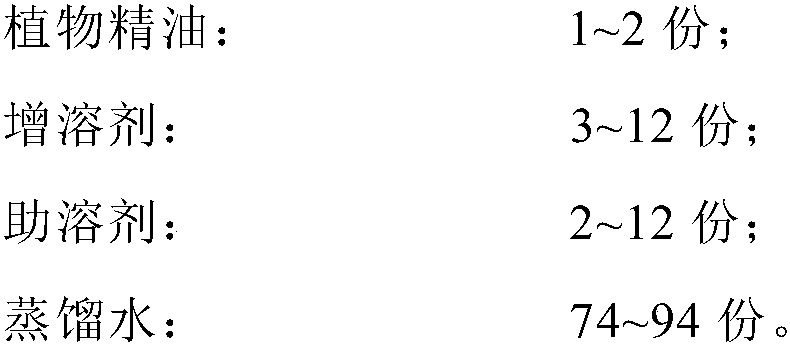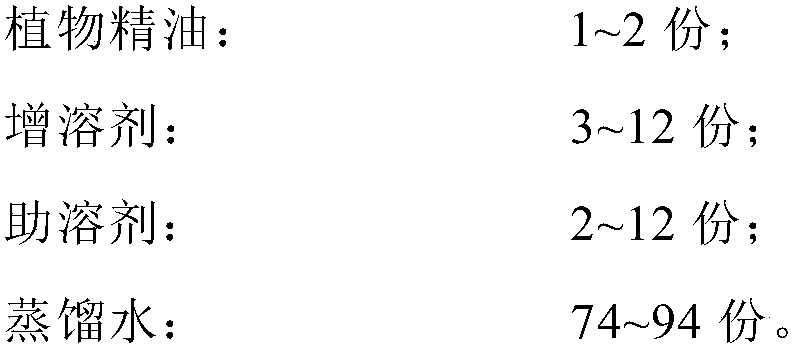Plant essential oil aqueous solvent composition and preparation method thereof
A plant essential oil and water solvent technology, which is applied in the fields of botanical equipment and methods, plant growth regulators, animal repellents, etc., can solve the problems of complex plant essential oil components and differences in the solubilization effects of essential oils, and achieves good application value, Clear and transparent appearance and fragrant smell
- Summary
- Abstract
- Description
- Claims
- Application Information
AI Technical Summary
Problems solved by technology
Method used
Image
Examples
Embodiment 1
[0038] Weigh 0.15 grams of cinnamon essential oil, 0.15 grams of litsea cubeba essential oil, 0.05 grams of lemon essential oil, 0.05 grams of thyme essential oil, 0.05 grams of peppermint essential oil, and 0.05 grams of tea tree essential oil into a 100 ml glass beaker. Add 3 grams of fatty alcohol polyoxyethylene ether 7 and 2.5 grams of absolute ethanol into the beaker. Stir the above essential oil, absolute ethanol and solubilizer evenly with a glass rod. Continue to add 25 grams of distilled water to the beaker. An electric stirrer was used to stir the above aqueous solution for 5 minutes at normal temperature to obtain a clear and transparent essential oil water solvent.
Embodiment 2
[0040] Weigh 2 grams of cinnamon essential oil, 1 gram of litsea cubeba essential oil, 0.5 gram of lemon essential oil, 0.5 gram of thyme essential oil, 0.5 gram of peppermint essential oil, and 0.5 gram of tea tree essential oil into a 500 ml glass beaker. Add 25 grams of fatty alcohol polyoxyethylene ether 7 and 25 grams of absolute ethanol in the beaker. Stir the above essential oils, absolute ethanol and solubilizer evenly with an electric mixer. Continue to add 195 grams of distilled water to the beaker. An electric stirrer was used to stir the above aqueous solution for 10 minutes at normal temperature to obtain a clear and transparent essential oil water solvent.
Embodiment 3
[0042]In this example, the antibacterial effect of the water solvents made from the individual essential oils included in the compound essential oils of the present invention was measured. At the same time, a water solvent containing no essential oil but containing ethanol and fatty alcohol polyoxyethylene ether 7 was used as a control group.
[0043] Preparation of essential oil water solvent: weigh 2 grams of cinnamon, litsea cubeba, tea tree, lemon, peppermint, and thyme essential oils and add them to a 500 ml glass beaker. Add 12 grams of fatty alcohol polyoxyethylene ether 7 and 10 grams of absolute ethanol to the beaker. Stir the above essential oil, absolute ethanol and fatty alcohol polyoxyethylene ether 7 evenly with a glass rod. Continue to add 76 grams of distilled water to the beaker. An electric stirrer was used to stir the above aqueous solution for 10 minutes at normal temperature to obtain a clear and transparent essential oil water solvent.
[0044] Prepara...
PUM
 Login to View More
Login to View More Abstract
Description
Claims
Application Information
 Login to View More
Login to View More - R&D
- Intellectual Property
- Life Sciences
- Materials
- Tech Scout
- Unparalleled Data Quality
- Higher Quality Content
- 60% Fewer Hallucinations
Browse by: Latest US Patents, China's latest patents, Technical Efficacy Thesaurus, Application Domain, Technology Topic, Popular Technical Reports.
© 2025 PatSnap. All rights reserved.Legal|Privacy policy|Modern Slavery Act Transparency Statement|Sitemap|About US| Contact US: help@patsnap.com



